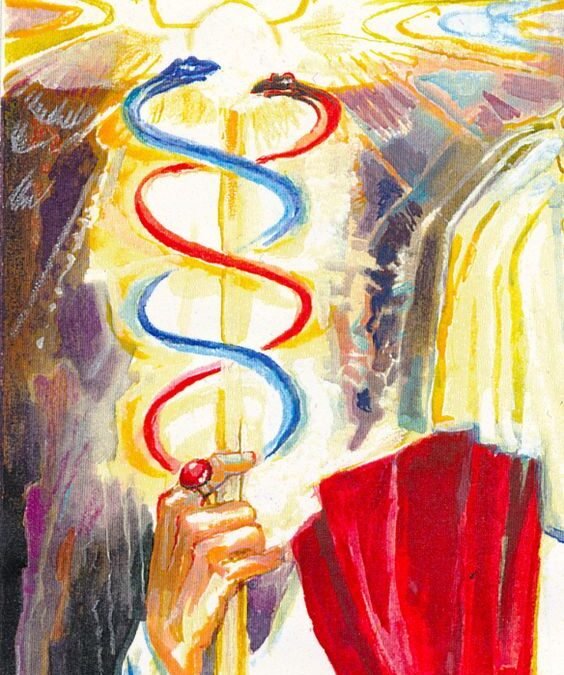The Caduceus from Greek Mythology is found in a large cross section of seemingly unrelated ancient civilisations. This is astounding in itself when one considers that critical to the reality of all these civilisations was one unique image… that of the serpent.
The Greeks interpret the caduceus as being the wand of mercury, their mythical god, or messiah of ancient Greece. The Caduceus is probably a title insignia so to speak, showing that this messenger is one speaking of truth from The Creation.
A central axis surrounded by four coils of ‘serpents’ is connected in some way to a disc with wings. The winged disc is most likely a re-enactment of the flying wheels or celestial discs of the angelic visitors to both ancient Egypt and Sumer. One thing becomes clear, that the ‘serpents’ coiled around the pillar with four coils are reminiscent of none other than another already familiar piece of Egyptian iconography. The Egyptian Djed column, the artefact for The Tree of Life itself, and as a hieroglyph translated as that which gives life.
No less than six instances of evidence of this precious symbol can be found when delving into the archives of ancient civilisations: In Mesopotamia, five thousand years ago. In Ancient Rome it was used as a symbol of equilibrium. In Ancient Greece as already mentioned. In ancient Egypt this emblem was adapted and was interpreted by the legendary Thoth as representing the powers of the four elements of creation: Earth, fire, wind and water, and the healing powers thereof. In ancient India it is inscribed on gravestones.
In more recent times, the Caduceus emblem has become accepted as the worldwide medical emblem for healing and medicine.
“In both the Western and Eastern Mystery traditions the vital energy polarities of the human nervous system are often symbolized by two snakes intertwined. These subtle energy channels are called the Nadi in Sanskrit and Od and Obd in Hebrew.According to Kundalini yoga, the Nadis can be thought of as energetic channels (not an anatomical structures). They are the plus and minus circuits of our bodies subtle electrical system.These two polarities Ida and Pingala (Od and Obd) intertwine around the spinal column or the Sushumna nadi (the middle pillar in Qabalah).They are symbolized in the western mystery tradition by the Caduceus of Hermes.“the two snakes of which symbolize the kundalini or serpent-fire which is presently to be set in motion along those channels, while the wings typify the power of conscious flight through higher planes which the development of that fire confers”.
~ C. W. Leadbeater

“The ancient Caduceus symbol used by the modern medical establishment symbolizes on a esoteric level the alchemical process. The staff represents the spinal column which correlates with the Sushumna Nadi channel of yogic esoteric anatomy. The two ascending spirals of snakes represent the solar and lunar currents known as the ida and pingala of the kundalini life force. The spiral pattern is similar to the spirals of the human DNA. The symbolism of Jacobs Ladder or Stairway to Heaven corresponds with the Staff of Life.The sphere at the top of the staff represents the energy center of the brain or the seventh chakra also known as the thousand petaled lotus. The Wings at the top of the staff is the culmination of the alchemical process. This represents freedom or liberation of the soul from the cycle of birth and death. One transcends the bonds of ego and bodily identification. The spirit is released from the confines of matter. Ultimately, this is the unfoldment of consciousness where by one realizes ones self to be infinite also known as self-realization.”
– Arion Love; Alchemy – The Science of Enlightenment
“Energetically, Ida and Pingala in Sanskrit are the plus and minus, masculine-feminine, Yin-Yang, Od and Ob in Kabbalistic terms, or Adam and Eve. These are energetic channels shown in the caduceus of Mercury and many symbols throughout the world, these two symbolic serpents that sit or entwine around a central serpent. Those are symbols of forces, energies.”
-Samael Aun Weor

